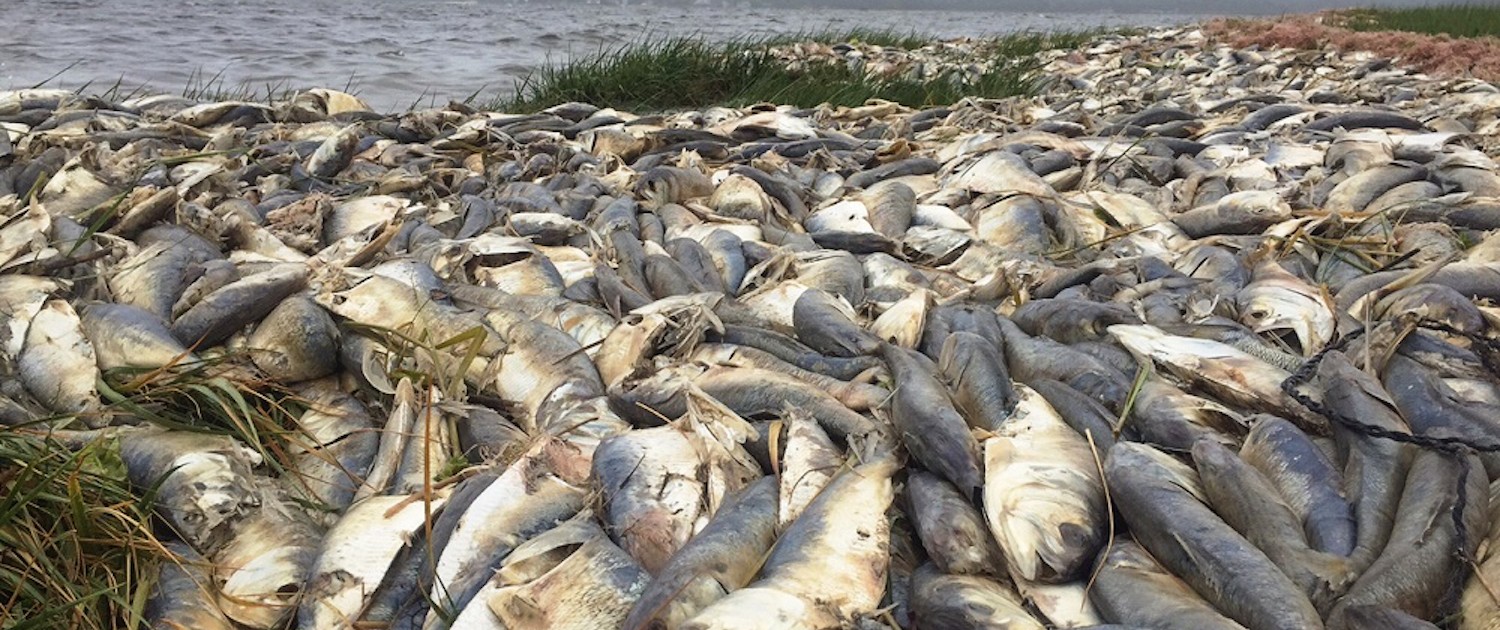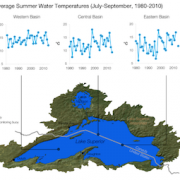Ecosystems Are Dying as Long Island Contends With a Nitrogen Bomb
Septic systems and nitrogen pollution are killing the island’s marine heritage

Dead fish pile up on the shore of Long Island’s Peconic Bay in this photo taken on June 1, 2015. The fish suffocated when an algae outbreak depleted the water of oxygen. Photo courtesy of Stefan Beaumont
By Brett Walton, Circle of Blue
Thousands of dead bunker fish and hundreds of diamondback turtles washed ashore last May in Peconic Bay on the east end of Long Island, New York. Fed by warming waters and a stream of nitrogen, a foul bloom of algae had so depleted the estuary of oxygen that marine life suffocated. The waters of the bay swirled red and brown.
The late-spring algae bloom was the beginning of a seasonal occurrence that has become distressingly common: a toxic summer in the waters of Long Island, the claw-like banner of land that extends 190-kilometers (118-miles) from Brooklyn to the Hamptons. Aureococcus, or brown tide, covered the south shore in June. Cochlodinium, or rust tide, appeared in Shinnecock Bay and Sag Harbor in early September. Between Memorial Day and Labor Day, at least 15 lakes were overwhelmed by microcystis, a toxin produced by blue-green algae.
We got away cheap with managing our waste. It’s all caught up to us.” Kevin McDonald,
The Nature Conservancy
“You see pictures on TV of water in every shade but clear,” Richard Amper, executive director of the Long Island Pine Barrens Society, a conservation group, told Circle of Blue.
Clear water is what Amper, who is 70, remembers from the Long Island summers of his youth. Clear water today is rare. The lethal palette that appears in the bays and rivers is a sobering signal that the island’s ecology is dangerously out of balance.
“You used to be able to wade shoulder deep and still see the bottom,” Amper recalled. “Now you can’t see your feet in two feet of water.”
Like the unfurling of sails or the aroma of sunscreen, the deadly algae blooms, as in so many urban and rural watersheds around the world, are now an annual rite of summer and not only on Long Island. Two-thirds of the 1,578-kilometer (981-mile) Ohio River was blanketed with algae in September. A bloom in Lake Erie that shut down the Toledo, Ohio, water system for days in August 2014 drew national attention to the long-festering problem.
In each case, the cause of the algae is a large pulse of nitrogen or phosphorus — plant vitamins that supercharge growth. For the Ohio River and Lake Erie, farm fertilizers are the primary contributors. But for Long Island the problem largely stems from a different source: household septic systems.
Septic systems — typically an underground tank to trap solid toilet waste and a pipe to let the liquid percolate into the soil — flourish in areas without connections to centralized sewage treatment plants. They provide an inexpensive, rudimentary barrier to the spread of disease if they are designed, installed, sited, and maintained properly. Nearly one in five American households uses such a system. An undetermined but substantial number are failing to protect human health and the environment.
Even properly functioning systems are flawed. Basic septic units are not designed to remove nitrogen. When too many households with septic are clustered too densely, nitrogen levels spike. Converted into ammonium in the tank and then nitrate in the soil, nitrogen seeps into groundwater and ends up in rivers, lakes, and bays, where it feeds a menagerie of algae species. The algae, in turn, starve the water of oxygen, kill fish, and turn clear water — an asset for tourism, recreation, commercial fishing, health, and property values — into a putrid mess.
The scenario has happened in the towns along Cape Cod and the Chesapeake Bay and in numerous springs and lagoons in Florida, which has more septic systems than any state.
Nowhere is the damage from nitrogen as severe, visible, and directly linked to septic systems as on Long Island. The problem is particularly acute in Suffolk County, which covers the eastern two-thirds of the island and where 1 million people use septic systems, a colossal number for such a small area. Seventy percent of Suffolk’s systems were built before 1972, when the county began requiring tanks. The pre-1972 systems pipe waste into sewage ponds, a feature generally associated in the public mind with animal feedlots. The contribution from individual units adds up. Sixty-nine percent of the nitrogen flowing into Great South Bay, a 100-kilometer (62-mile) coastal stretch, comes from septic pollution.
As a result, the Long Island ecosystem has seen catastrophic collapse. Eelgrass, which provides scallop, oyster, and clam habitat and also buffers tidal surges like those wrought by Hurricane Sandy, is on the verge of extinction, down 90 percent from 1930. Salt marshes, a partner in storm buffering, are dying. Shellfish harvests are one-tenth what they were three decades ago, at a cost of at least 6,000 jobs. Nitrate levels in groundwater supplies are rising and they exceed federal drinking water standards in 10 percent of residential wells. Groundwater is the sole source of drinking water for most Long Islanders, and nitrate interferes with the blood’s capacity to carry oxygen. It is debilitating and potentially deadly for infants.
Altogether, the environmental damage from septic systems is felt in every corner of Long Island life. Just as in the other regions contending with dangerous levels of contamination the root causes in Long Island are similar as well — a striking civic indifference until the mess can’t be ignored any longer. The harm is so bad that the public and politicians are now reckoning with a long-running ecological bill that has come due, argues Kevin McDonald, public lands program director for The Nature Conservancy on Long Island.
“We decided to handle sewage in a relatively inexpensive way over the last 50 years,” McDonald told Circle of Blue. “We got away cheap with managing our waste. It’s all caught up to us. We found out what the consequences are and people don’t like it. The adult decision that has to be made now is: are we going to finally correct what has caught up to us?”
McDonald and others are more hopeful now than ever before. Lawmakers at all levels of government have pledged to chart a new course. Steve Bellone, the Suffolk County executive, said in January 2014 that water quality is “the most important priority of my administration.” A Suffolk County water management plan published this spring, which has 15 recommendations for reducing nitrogen, refers to the county’s “nitrogen bomb” as “public water enemy #1.” Governor Andrew Cuomo’s recent budget committed $US 5 million for a study, to be led by the U.S. Geological Survey, that will determine nitrogen limits for key watersheds. Last year, the state secured $US 383 million from federal sources to connect 10,000 homes in the most degraded basins to sewers.
“The recognition that we have to modernize and have to do better is upon policy makers,” McDonald asserted.
New Resolve for Long Island
Why is septic suddenly Suffolk County’s top priority? Observers offer several explanations.
They begin with better research. Though problems with septic systems and nitrogen on Long Island were identified as far back as a 1978 study that was funded by the U.S. Environmental Protection Agency, the conclusions were largely ignored. “Everyone treated the brown tides as alien encounters,” McDonald said, recalling when the first brown tide appeared in 1985. “The thinking was, ‘Gee, the tides showed up. Maybe they won’t come back.’”
In the last five years, however, more detailed and respected studies emerged. In 2010, the New York State Department of Environmental Conservation (NYSDEC) published a report on the decline of seagrass beds. In 2011, researchers at Woods Hole calculated the amount of nitrate pollution in Great South Bay that came from septic systems. In 2014, the NYSDEC issued a report on the harm to coastal wetlands from nitrate.
All along, researchers at Stony Brook University were producing dozens of papers that dissected the algae life cycle and connected the severity of the blooms to increases in nitrate. Because nitrate moves slowly through the ground, the pollution entering the bays today may have started its journey three decades ago or more. They also found that increases in nitrate induced the microcystis cells to produce more toxins than under low-nitrate conditions.
The second factor was Hurricane Sandy. When the big storm roughed up the mid-Atlantic in October 2012, the damage was immense — $US 1.8 billion in Suffolk County alone. The loss of wetlands and seagrasses compounded the destruction. Marshes can dampen half a wave’s energy within three meters, according to one study. Without them, waves have an open gate to the castle. New York secured $US 383 million in federal Hurricane Sandy rebuilding money to connect 10,000 homes in Suffolk County to sewers.
And finally, there are the images. With the fish kills and swirls of algae appearing all over Facebook, Twitter, newspapers, and television, the problem is too obvious to ignore. “For the first time, people are really seeing the adverse impact on the place they love,” Richard Amper remarked.
Officials Recognize the Problem
That awareness extends to those elected to high office, from county officials to state authorities.
“I’ve never seen government — all levels of government — say, ‘Yes, the problem is real and we all have a responsibility to fix it,’” said Amper, who has worked on conservation on Long Island for 30 years. “It’s remarkable. I’ve never seen anything like it.”
Amper said a major effort begin three years ago with the creation of the Long Island Clean Water Partnership, of which the Pine Barrens Society is a member. The partnership spread the scientific community’s growing understanding of the problem to both the public and officials.
Then in 2015, Suffolk County released a new water management plan, the first update since 1987. The plan identifies 15 recommendations for nitrogen reduction and includes 49 specific actions. Several of the items are already being acted on. In addition to the sewer extensions, the county is testing alternative septic technologies that will cut nitrogen discharges by half. The demonstrations are being run for 19 systems, according to Chris Lubicich, chief of the Suffolk County Office of Ecology. The county is also accepting applications for small-scale sewage treatment units, which are decentralized solutions that could serve a subdivision or several hundred homes. And it is upgrading old wastewater treatment plants, which account for a smaller portion of the nitrogen.
“We’re progressing on a number of fronts,” Lubicich told Circle of Blue. Other efforts target lawn fertilizer use and agricultural runoff, which also contribute to the problem.
The latest effort, which kicked off in October, is the $US 5 million state-funded nitrogen study. By March 2017, officials should have in their hands a nitrogen budget for key watersheds. Such goals already exist for Long Island Sound and Peconic estuary under the EPA’s TMDL program, but they focus on wastewater plants and other point sources and conservation groups have complained that they are not rigorous enough.
In some ways, acknowledging the problem may be the easiest step.
“What has been proposed is going to begin to do the job,” said Chris Gobler, a professor at Stony Brook University and one of the leading experts on nitrogen pollution in Long Island. “They are taking a staged approach and looking at the highest priority areas first. But then there is more to be done. There’s always more that can be done.”
As with any change in civic practices, money will be a paramount concern. Building out a sewer system is not cheap, as the Hurricane Sandy funding shows, and sewers lead to worries about rural growth and development. Septic systems that remove nitrogen are more than twice the cost of a traditional system. To encourage installation, McDonald said that governments could incentivize homeowners with rebates, as they do for the purchase of low-flow toilets or efficient light bulbs.
“This is a solvable problem when people decide to pay for it,” McDonald said. “Of course the flip side is that we are paying the price for our nitrogen problems already.”
Brett writes about agriculture, energy, infrastructure, and the politics and economics of water in the United States. He also writes the Federal Water Tap, Circle of Blue’s weekly digest of U.S. government water news. He is the winner of two Society of Environmental Journalists reporting awards, one of the top honors in American environmental journalism: first place for explanatory reporting for a series on septic system pollution in the United States(2016) and third place for beat reporting in a small market (2014). He received the Sierra Club’s Distinguished Service Award in 2018. Brett lives in Seattle, where he hikes the mountains and bakes pies. Contact Brett Walton









Leave a Reply
Want to join the discussion?Feel free to contribute!